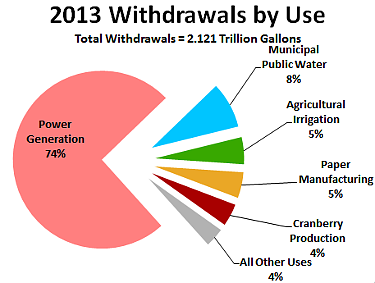
The Wisconsin Department of Natural Resources (WDNR) released its annual report on water withdrawals in Wisconsin. Wisconsin withdraws about 2.2 trillion gallons of water each year from ground and surface water sources. According the WDNR, that is enough water to fill Lambeau Field about 4,700 times.
All property owners with systems capable of withdrawing 100,000 gallons of water each year are required to register and report withdrawals. Wisconsin has over 14,000 registered sources that use water for a variety of purposes. The largest use is for cooling in electric power generation. Other uses include municipal public water, agricultural irrigation, paper manufacturing, and cranberry production. WDNR’s report finds that withdrawals totaled 2.2 trillion in 2013, 6.1 percent lower than withdrawals in 2012. WDNR also estimates that Wisconsin contains over 800,000 unregistered low capacity wells that serve homes, farms, and businesses using 50 to 75 billion gallons of water per year.
Water withdrawals from surface water totaled 1.87 trillion gallons for 682 active sources. Of the total surface water withdrawals, 84.4 percent was used in power production concentrated along Lake Michigan and the Wisconsin and Mississippi Rivers. Total surface water withdrawals decreased by nearly five percent from 2012 driven by declining municipal and cranberry production use. Surface water use in non-metallic mining saw a 25 percent increase due to increased dewatering. Groundwater withdrawals totaled 250 billion gallons from 13,000 registered sources. Groundwater use is driven by agricultural irrigation and municipal water usage. Of the total groundwater withdrawals, 40 percent was used in agricultural irrigation and 37 percent was used in municipal public water systems. In total, 88 percent of all statewide water withdraws were made from surface water sources, while ground water accounted for 12 percent.
Read the full report here.